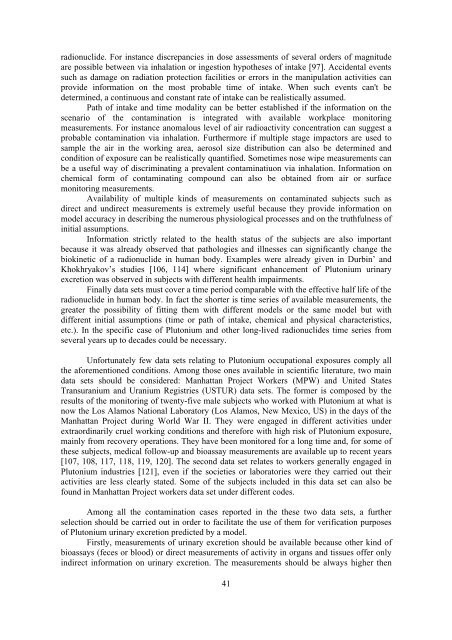Plutonium Biokinetics in Human Body A. Luciani - Kit-Bibliothek - FZK
Plutonium Biokinetics in Human Body A. Luciani - Kit-Bibliothek - FZK
Plutonium Biokinetics in Human Body A. Luciani - Kit-Bibliothek - FZK
You also want an ePaper? Increase the reach of your titles
YUMPU automatically turns print PDFs into web optimized ePapers that Google loves.
adionuclide. For <strong>in</strong>stance discrepancies <strong>in</strong> dose assessments of several orders of magnitude<br />
are possible between via <strong>in</strong>halation or <strong>in</strong>gestion hypotheses of <strong>in</strong>take [97]. Accidental events<br />
such as damage on radiation protection facilities or errors <strong>in</strong> the manipulation activities can<br />
provide <strong>in</strong>formation on the most probable time of <strong>in</strong>take. When such events can't be<br />
determ<strong>in</strong>ed, a cont<strong>in</strong>uous and constant rate of <strong>in</strong>take can be realistically assumed.<br />
Path of <strong>in</strong>take and time modality can be better established if the <strong>in</strong>formation on the<br />
scenario of the contam<strong>in</strong>ation is <strong>in</strong>tegrated with available workplace monitor<strong>in</strong>g<br />
measurements. For <strong>in</strong>stance anomalous level of air radioactivity concentration can suggest a<br />
probable contam<strong>in</strong>ation via <strong>in</strong>halation. Furthermore if multiple stage impactors are used to<br />
sample the air <strong>in</strong> the work<strong>in</strong>g area, aerosol size distribution can also be determ<strong>in</strong>ed and<br />
condition of exposure can be realistically quantified. Sometimes nose wipe measurements can<br />
be a useful way of discrim<strong>in</strong>at<strong>in</strong>g a prevalent contam<strong>in</strong>atiuon via <strong>in</strong>halation. Information on<br />
chemical form of contam<strong>in</strong>at<strong>in</strong>g compound can also be obta<strong>in</strong>ed from air or surface<br />
monitor<strong>in</strong>g measurements.<br />
Availability of multiple k<strong>in</strong>ds of measurements on contam<strong>in</strong>ated subjects such as<br />
direct and undirect measurements is extremely useful because they provide <strong>in</strong>formation on<br />
model accuracy <strong>in</strong> describ<strong>in</strong>g the numerous physiological processes and on the truthfulness of<br />
<strong>in</strong>itial assumptions.<br />
Information strictly related to the health status of the subjects are also important<br />
because it was already observed that pathologies and illnesses can significantly change the<br />
biok<strong>in</strong>etic of a radionuclide <strong>in</strong> human body. Examples were already given <strong>in</strong> Durb<strong>in</strong>’ and<br />
Khokhryakov’s studies [106, 114] where significant enhancement of <strong>Plutonium</strong> ur<strong>in</strong>ary<br />
excretion was observed <strong>in</strong> subjects with different health impairments.<br />
F<strong>in</strong>ally data sets must cover a time period comparable with the effective half life of the<br />
radionuclide <strong>in</strong> human body. In fact the shorter is time series of available measurements, the<br />
greater the possibility of fitt<strong>in</strong>g them with different models or the same model but with<br />
different <strong>in</strong>itial assumptions (time or path of <strong>in</strong>take, chemical and physical characteristics,<br />
etc.). In the specific case of <strong>Plutonium</strong> and other long-lived radionuclides time series from<br />
several years up to decades could be necessary.<br />
Unfortunately few data sets relat<strong>in</strong>g to <strong>Plutonium</strong> occupational exposures comply all<br />
the aforementioned conditions. Among those ones available <strong>in</strong> scientific literature, two ma<strong>in</strong><br />
data sets should be considered: Manhattan Project Workers (MPW) and United States<br />
Transuranium and Uranium Registries (USTUR) data sets. The former is composed by the<br />
results of the monitor<strong>in</strong>g of twenty-five male subjects who worked with <strong>Plutonium</strong> at what is<br />
now the Los Alamos National Laboratory (Los Alamos, New Mexico, US) <strong>in</strong> the days of the<br />
Manhattan Project dur<strong>in</strong>g World War II. They were engaged <strong>in</strong> different activities under<br />
extraord<strong>in</strong>arily cruel work<strong>in</strong>g conditions and therefore with high risk of <strong>Plutonium</strong> exposure,<br />
ma<strong>in</strong>ly from recovery operations. They have been monitored for a long time and, for some of<br />
these subjects, medical follow-up and bioassay measurements are available up to recent years<br />
[107, 108, 117, 118, 119, 120]. The second data set relates to workers generally engaged <strong>in</strong><br />
<strong>Plutonium</strong> <strong>in</strong>dustries [121], even if the societies or laboratories were they carried out their<br />
activities are less clearly stated. Some of the subjects <strong>in</strong>cluded <strong>in</strong> this data set can also be<br />
found <strong>in</strong> Manhattan Project workers data set under different codes.<br />
Among all the contam<strong>in</strong>ation cases reported <strong>in</strong> the these two data sets, a further<br />
selection should be carried out <strong>in</strong> order to facilitate the use of them for verification purposes<br />
of <strong>Plutonium</strong> ur<strong>in</strong>ary excretion predicted by a model.<br />
Firstly, measurements of ur<strong>in</strong>ary excretion should be available because other k<strong>in</strong>d of<br />
bioassays (feces or blood) or direct measurements of activity <strong>in</strong> organs and tissues offer only<br />
<strong>in</strong>direct <strong>in</strong>formation on ur<strong>in</strong>ary excretion. The measurements should be always higher then<br />
41












![{A1[]Sp - Bibliothek](https://img.yumpu.com/21908054/1/184x260/a1sp-bibliothek.jpg?quality=85)




